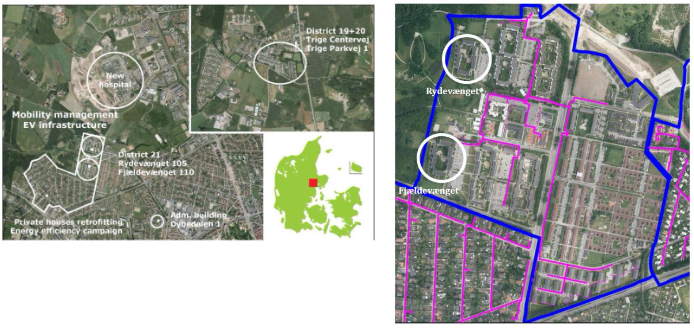Describing system benefits of low temperature district heating (LTDH)
Supply Area 114 Hasle. The blue line marks the overall area, the pink lines are themain supply pipes, and the white circles marks the two building areas involved in the READY project, Rydevænget and Fjældevænget.
The District Heating (DH) in the area consists of 4,327 meters supply & return pipes. The current annual average supply and return temperature from the heating station is 73.5°C and 43.3°C, respectively.
In summary the main findings of this work of describing system benefits of low temperature district heating are:
- An analysis of a DH area in the READY project which is to be energy-retrofitted indicates that, generally, careful analysis of the conditions in the specific DH area must be conducted if the DH providers are to harvest any energy-saving advantages.
- Decreasing the DH supply temperature for an existing Danish detached single-family dwelling built in the 1960’ies/early 1970’ies from 70/40°Cto 55/30°C results in 228 hours (9.5 days) where the radiator systems of the building is not able to maintain a room temperature of 20°C. To avoid this, the building envelope can be upgraded in an energy retrofit. It is technical and practical possible to upgrade the building envelope of the existing single-family dwellings to be able to maintain thermal comfort using DH of 55/30°C. However, the economic feasibility of the investment in the measures needed has to be considered. Normally shifting of window glassing and additional roof insulation would be sufficient. Maybe a few radiators need to be shifted to larger size of heating surface. Alternatively the DH temperature can be raised slightly during these 228 hours.
- The production of domestic hot water is an important issue when shifting to LTDH. Boosting technologies are required to meet health and comfort requirements.
- Investigations on whether measures which are not private-economic efficient may be economic efficient for district heating companies to enter is recommended for future work as there might be opportunities for new business models.
- Converting to LTDH leads to various economic-efficient opportunities for integrating large-scale heat pumps and solar thermal in the DH production system.
Want to know more?
Deliverable no. D.3.2.2 Describing system benefits of low temperature district heating
Please contact: Steffen Petersen, Aarhus University

